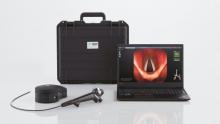This guideline has now been superseeded by the 2015 intubation guidelines click here
Regular national airway meetings have been held in the UK since 1986, and there has been much formal and informal discussion. The Society would recommend the following steps as those which represent good practice in airway management in 2007.
Difficult Airway Society 2007
- Practitioners should be competent in a number of core airway skills.
- For anaesthetists, the generic core airway skills are described in the documentation of the Royal College of Anaesthetists.
 Right click to download RCA SpR Airway Skills
Right click to download RCA SpR Airway Skills
- For anaesthetists, the generic core airway skills are described in the documentation of the Royal College of Anaesthetists.
- Practitioners should work in an appropriate environment.
- For anaesthetists this means that they work with trained assistance, with access to a range of airway devices and techniques outlined in the core skills, with appropriate monitoring during surgery and facilities for the appropriate level of postoperative care.
- All patients should undergo an airway evaluation pre-surgery and this should be recorded on the anaesthesia record.
- Airway evaluation is imperfect in predicting problems and an airway strategy (combination of plans) should be drawn up for each patient to cover the entire period of anaesthetic care, particular at the start and end of anaesthesia.
- Written guidelines should exist in each department to cover a number of common or serious airway problems.
- For anaesthetists in the operating theatre, strategies should be ready for;
- Rapid Sequence Induction set-up
- Rapid Sequence Induction See DAS guideline for RSI strategy -
- Direct Laryngsocopy and unexpected failure See DAS guideline for default intubation strategy
- Failed ventilation See DAS guideline for CVCI
- Predicted difficult direct laryngsocopy, easy facemask inflation
- Awake intubation
- Acute upper airway obstruction
- For anaesthetists in the operating theatre, strategies should be ready for;
- When the airway has proved difficult to manage a difficult airway follow-up should be initiated in the postoperative period. Read more ..
- Morbidity or mortality due to airway management should be presented at department clinical governance meetings.
- National data on the prevalence of serious morbidity/mortality related to airway management should be collected. Lessons learned should be disseminated rapidly throughout the specialty.
Formation of Guidelines
The UK guidelines are novel and the 'rules' followed to construct them are as follows;
- The guidelines are constructed with common-sense aided where possible by 'evidence', rather than being driven by a false sense of the priority of evidence-base in airway literature. The fact that an expert can use a particular device successfully is no reason to imagine that it should necessarily be a core skill.
- The guidelines will be reviewed and re-published annually because the Society is able to do so.
- The guidelines are constructed with regard to the culture, skill and equipment available in the UK.
- The guidelines address very specific scenarios. It is not possible to reduce the whole of airway management to one side of A4.
- The guidelines recommend using only techniques or equipment that are incorporated into the airway core skills outlined in the RCA documents. There is no point in publishing airway guidelines incorporating techniques which are not widespread.
- The techniques in the core skills have been chosen with the aim of producing the smallest repertoire of devices/skills to cover the widest range of airway problems. The small repertoire aids training.
- Transferable skills are better than end-skills, so if the fibrescope is to be used for one technique it is better to use it in another situation, rather than learn a brand new skill.
- Having national core skills has advantages in provision of training, equipment and practice in a national Health Service. Trainees who move between hospitals can reasonably expect to find standard equipment, and anaesthetic assistants can become experienced with a small range of equipment. It is not possible or correct to imagine that all hospitals should stock a complete set of the very wide range of airway equipment.
- Intubation devices/techniques which are visually guided are preferable to blind techniques.
- Intubation techniques which allow easy ventilation around, or during, intubation are preferable to ones which can be done only in apnoea.
- Intubation techniques which are non-invasive are preferable to 'invasive' ones (e.g retrograde intubation), provided that both are equally successful.
- An individual practitioner can make a judgement about which equipment/technique to use, and is quite entitled to use any which is commercially available.
- Many new supraglottic devices are produced and promoted for commercial reasons rather than because they outperform the core equipment. The core equipment can change to reflect what is best.
- If the guidelines don't have the ring of common sense, nobody will use them. Let us know by e-mailing the Society Secretary.
The DAS algorithms can be reproduced for non-commercial purposes without explicit request for permission as long as there is proper citation. For more information click here
